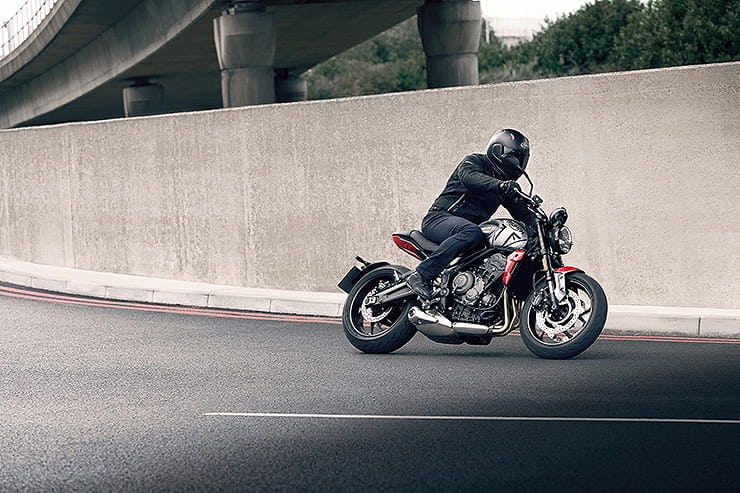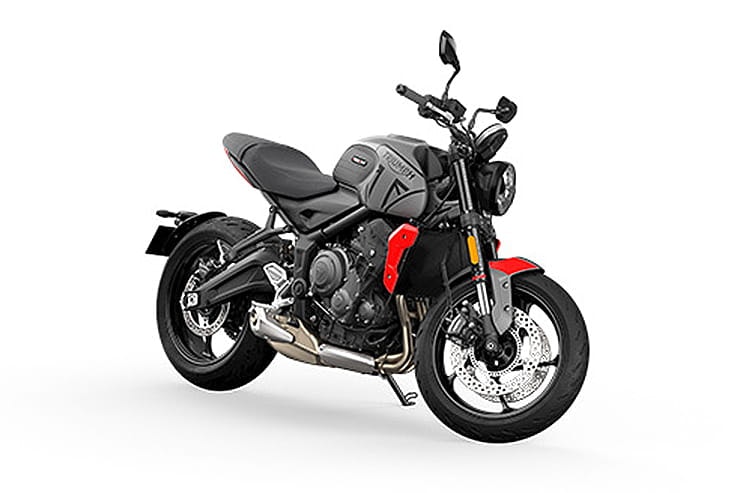Triumph Trident (2021) – in detail
By Michael Mann
BikeSocial Managing Editor
30.10.2020
*Full Triumph Trident review available here*
Friendly, mid-capacity roadsters are all the rage, and the sales chart evidence highlights that fact but up until now there’s been an obvious omission in the shape of a well-known British manufacturer. Well, sort of. Behold the new 2021 Triumph Trident – a 660cc, three-cylinder, A2 compliant, £7195 opponent to the Yamaha MT-07, Kawasaki Z650 and Honda CB650R that have been grabbing a large percentage of this competitive market in recent times.
Yes, the British marque has had the Street Triple S on its books since January of this year as an accomplice to the R and RS but with a 660cc engine making 47bhp (the limit of what’s legal for A2 licence holders) rather than the R and RS’s 765cc version making 116bhp and 121bhp respectively.
However, the new Trident has been earmarked as a restrictable naked demonstrating Triumph’s ambition to introduce a new generation of riders to the brand with a well-balanced package containing strong rider ergonomics, style and quality mixed with performance, a three-cylinder motor and a range of rider aids. This could be the most important motorbike Triumph bring to the market in years.
From the white prototype unveiled at the London Design Museum in August, we can now reveal all the details of the new Triumph which will be available in UK dealerships in late January 2021 and we’re hoping to have a test ride before then, so keep your eyes here at Bennetts BikeSocial for the first review.
The Trident name has been associated with the brand since 1968 when the bike also known as the BSA Rocket 3 went on to win five consecutive Isle of Man Production TTs but then came the 750cc and 900cc triple roadsters in 1990, so the name has history but the 2021 embodiment is nothing like those that have passed before.
ALL the Triumph Trident details
BikeSocial’s Michael Mann quizzes Triumph’s Chief Product Officer, Steve Sergeant about the new entry-level Trident
2021 Triumph Trident Engine and Performance
The top line figures make for hearty reading. It’s peak power of 80bhp at 10,250rpm and 64Nm peak torque at 6,250rpm tell only half the tale because, as Triumph’s Chief Product Officer, Steve Sergeant explained, “We wanted to create an all-round bike that’s unintimidating.” Power-related performance was not the ultimate ambition but rather a bike that serves the realistic goal of accessibility, comfort and style but could still mix it with the competitors.
The 3-cylinder engine layout is synonymous with Triumph, they have a long history with developing this type of engine with the 675, 765, 800 and now the 900 Tiger, all of which stem from the same single platform. The crank cases on the Euro 5-friendly Trident are from the Street Triple S but internally the bore is smaller, the stroke is longer, the crankshaft profiles, pistons, rings, input and output shafts, selector drum are all different while there’s also a new airbox, throttle bodies, intake manifold, header system, and more, so there’s a lot of differences too.
But why? Despite the three-cylinders which represents an extra bit of weight in the engine vs. the twins that are considered rivals, the engineers wanted to match/beat the performance of the twins in the low-mid range but also the high-end of the inline four. All while maintaining a competitive weight, and in contrast to normal Triumph behaviour, the wet (or kerb) weight has been quoted, and at 189kg it’s almost identical to the Kawasaki Z650, lighter than the Honda but not as light as the Yamaha.
A broad torque range was another focus for the Hinckley-based engineers during the bike’s four-year development programme. While peak power is 64Nm at 6,250rpm, the type of riders Triumph are trying to attract are less likely to rev the Trident hard, 90% of that peak figure is available from 3,600 rpm right up to 9,750rpm giving the bike plenty of applicable performance.
Widening that customer base further, and just like its rivals, the Trident is also A2 licence compliant. A simple accessory fit conversion kit amends the throttle’s twist grip and engine tune which a dealer can then derestrict the bike once a full licence is acquired.
2021 Triumph Trident Chassis, Suspension and Brakes
The upright yet sporty riding position is surrounded by styling inspired by both the Speed Twin and Street Triple ranges to keep the Triumph-ness of the Trident apparent. And that is bolted to a completely new chassis – a steel, tubular, fabricated frame with a short wheelbase offers stability, agile and that sense of unintimidation too. A buxom machine with a wide stand-over is never going to be a favourite of the less experience.
Speaking of which, the 805mm high seat focuses on a narrow width and plenty of foam padding which is why Triumph changed the airbox profile and the central package so the rider can easily get both feet flat on the ground and the bike becomes easy to manage at low or no speed.
The Trident comes with quite a high specification for this market too; Showa forks and rear shock unit (with pre-load adjustment) are coupled with double Nissin brakes discs on the front and a single one for the rear plus Michelin Road 5 tyres, and then there’s the electronics package…
Above: New TFT display, the new switchgear and an example of what an accessorised version looks like
Rider Aids, Electronics and Accessories
The two rider modes, Road and Rain, come with dedicated traction control settings and ride-by-wire throttle mapping. Traction control can be turned off too.
It wouldn’t be a Triumph with a raft of dedicated accessories, and 45 of them are on offer here, covering security, performance, style and protection. The highlights of which must surely be the up and down quickshifter, an under-seat USB charging socket and the My Triumph connectivity allowing an app to control your GoPro, check your messages, turn-by-turn navigation all via the new switchgear connected to the new multi-functional colour TFT display. I’d be fitting the fly screen and heated grips too.
All-LED lighting plus the tapered fuel tanks sides, 5-spoke 17” cast aluminium wheels are further evidence to the build quality and finish of the Trident.
2021 Triumph Trident price, colour range, cost of ownership
A two-year, unlimited mile warranty is matched with a 10,000-mile service interval with an average workshop time at a claimed 25% lower than the competition leaving customers with a few more pounds in their pockets after a couple of years of ownership.
A 14-litre fuel tank has been designed for this model with the waist of the bike where the tank meets the saddle of importance to allow ease of access to and from the machine. As opposed to the 17.4 litre version on the Street Triple S. Triumph didn’t have the official homologated consumption figures available at the time of the bike’s launch but there’s a strong case for a mid-50s mpg figure.
Of the four colour options: Crystal White, Matt Jet Black & Matt Silver Ice, Sapphire Black, Silver Ice & Diablo Red with an extra £100 premium on top of the £7195 price for the two with the larger Triumph logo on the side (Matt Jet Black & Matt Silver Ice plus Silver Ice & Diablo Red)
Rivals
The hottest ticket in town for big sales is a lightweight, mid-capacity naked and all the main player have one. Triumph named their three closest competitors listed on the table below – a couple of twins and an in-line four but you could easily include Suzuki’s SV650 and the KTM 790 DUKE into the mix.
2021 Triumph Trident Specification
Share on social media:


